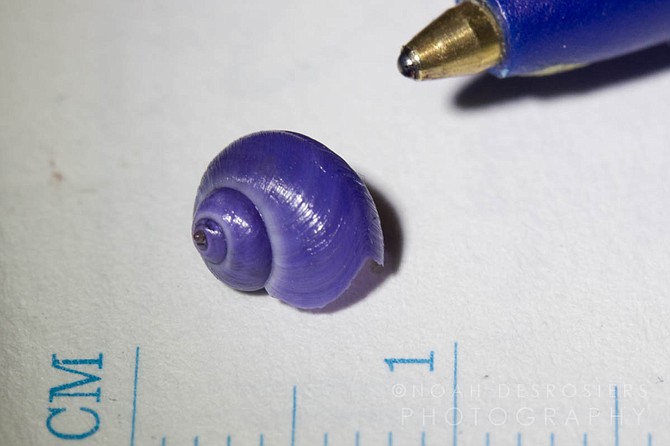 Facebook
Facebook
 X
X
 Instagram
Instagram
 TikTok
TikTok
 Youtube
Youtube

Commonly called violet sea-snails or purple bubble raft snails, Janthina janthina is a creature you’re more likely to find in Aruba than Ocean Beach, but one beachcomber found a half dozen of the shells along the beach this week.
“I combed O.B. from the pier to Dog Beach and found a half dozen Janthina shells blown in by the wind,” said Noah DesRosiers on Facebook. “This little shell is an adult snail that lives far offshore in warmer waters. They avoid sinking by making a raft of snot bubbles. Strong winds can blow them off course and, as I understand it as a new resident, somewhat uncommon on California beaches.”
DesRosiers, who holds a master’s in marine biology, explained further.
“I vastly prefer learning about our planet to watching Netflix or listening to humans blather on about other humans,” DesRosiers told me. “And after so many years of staring at the sea and its creatures, you build up a pretty workable understanding of what's out there….
“The various species of Janthina live worldwide offshore in open water — i.e. they are 'pelagic' — and yes they support their heavy 1-cm shells at the surface by making a mucus bubble raft. Winds and currents (like our recent storms + maybe an effect from last year's El Niño moving warm water and its animals over here) will blow them in and then on to shore. Also blown in are their prey, a jellyfish relative called Velella — of which I also found a few Monday [February 27].”
After a Monday’s storm, several leopard sharks washed up in Ocean Beach.


Commonly called violet sea-snails or purple bubble raft snails, Janthina janthina is a creature you’re more likely to find in Aruba than Ocean Beach, but one beachcomber found a half dozen of the shells along the beach this week.
“I combed O.B. from the pier to Dog Beach and found a half dozen Janthina shells blown in by the wind,” said Noah DesRosiers on Facebook. “This little shell is an adult snail that lives far offshore in warmer waters. They avoid sinking by making a raft of snot bubbles. Strong winds can blow them off course and, as I understand it as a new resident, somewhat uncommon on California beaches.”
DesRosiers, who holds a master’s in marine biology, explained further.
“I vastly prefer learning about our planet to watching Netflix or listening to humans blather on about other humans,” DesRosiers told me. “And after so many years of staring at the sea and its creatures, you build up a pretty workable understanding of what's out there….
“The various species of Janthina live worldwide offshore in open water — i.e. they are 'pelagic' — and yes they support their heavy 1-cm shells at the surface by making a mucus bubble raft. Winds and currents (like our recent storms + maybe an effect from last year's El Niño moving warm water and its animals over here) will blow them in and then on to shore. Also blown in are their prey, a jellyfish relative called Velella — of which I also found a few Monday [February 27].”
After a Monday’s storm, several leopard sharks washed up in Ocean Beach.
Comments